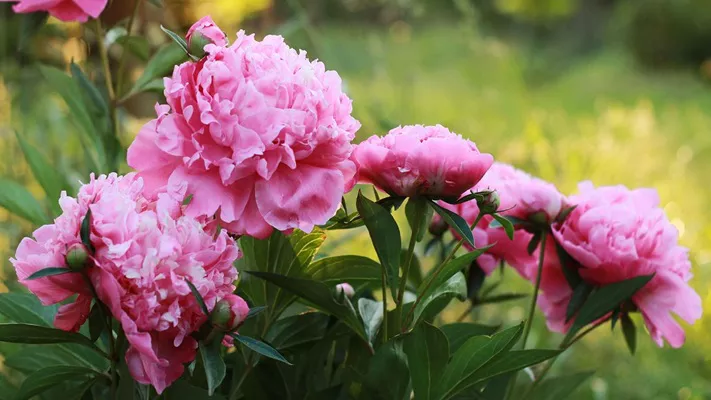Peonies are beloved for their large, fragrant blooms that bring beauty and elegance to gardens. However, getting more flowers on your peony plants can be a bit tricky. In this article, we’ll explore effective methods to encourage peonies to bloom more and produce vibrant, long-lasting flowers. These tips are easy to follow and will help ensure that your peonies thrive and produce more flowers year after year.
1. Choose the Right Location for Your Peonies
Peonies thrive in sunny spots with good air circulation. They need at least 6 hours of sunlight each day to bloom properly. When selecting a planting site, make sure it is well-drained because peonies dislike wet feet, which can lead to root rot.
To maximize flower production, avoid planting your peonies in areas where they’ll be shaded by large trees or structures, as this will limit their sun exposure.
2. Plant Peonies at the Right Depth
The depth at which you plant your peonies significantly affects their ability to bloom. If peonies are planted too deep, they may struggle to bloom, while those planted too shallow can be stressed by environmental changes.
The ideal depth for planting peonies is around 2 inches below the soil surface for herbaceous peonies. For tree peonies, plant them at a slightly shallower depth. Be sure to avoid planting them too deep, as this can stunt their growth and reduce flowering.
3. Provide Well-Draining Soil
Peonies require well-drained, fertile soil to thrive. Heavy clay or poorly draining soil can cause the roots to suffocate, leading to weak plants that may not flower properly.
Improve your soil by adding organic matter such as compost or well-rotted manure. This will help with both drainage and nutrition. Peonies prefer slightly acidic to neutral soil, so aim for a pH between 6.5 and 7.0.
4. Fertilize Regularly and Properly
Fertilization is key to getting more flowers from your peonies. However, it’s important not to over-fertilize, as this can lead to lush foliage at the expense of blooms.
During the early spring, before new growth appears, apply a balanced, slow-release fertilizer or one that is low in nitrogen. Excessive nitrogen promotes leaf growth but can reduce flower production. After flowering, you can apply a balanced fertilizer again to encourage strong root development for the next season.
5. Water Consistently but Don’t Overwater
Peonies need consistent moisture to grow and flower well, but they do not like to sit in waterlogged soil. Water them deeply once a week, especially during dry periods, but make sure the soil drains well to prevent water from accumulating around the roots.
Mulching around your peonies can help maintain soil moisture while keeping the roots cool and reducing weeds.
6. Remove Dead Foliage and Flowers
Deadheading is an important practice for peony plants. Once the flowers have faded, remove the spent blooms to prevent them from going to seed. This allows the plant to redirect its energy from seed production into strengthening its roots and producing more flowers next season.
In addition to deadheading, be sure to cut back any dead or diseased foliage throughout the growing season. This helps the plant stay healthy and prevents the spread of disease.
7. Support Peony Plants
Peony plants can become top-heavy, especially when they are covered with large blooms. Providing support for your peonies will help them stand upright and prevent their stems from breaking under the weight of the flowers.
Use a sturdy peony support or a flower cage to keep the stems upright. Make sure the support is placed early in the growing season to avoid damaging the plant later on.
8. Prune Your Peonies After Blooming
After your peonies finish flowering, it’s a good idea to prune them back to encourage new growth. Cut back any dead stems to the ground to help maintain the plant’s shape and improve airflow around the stems.
Be careful not to cut back too much, as peonies need their foliage to store energy for next season’s blooms. Just trim away the dead or damaged portions.
9. Avoid Overcrowding
Peonies need space to grow properly. If planted too closely together, they will compete for nutrients, water, and sunlight, which can affect flower production.
When planting peonies, ensure that there is adequate spacing between plants—typically 3 to 4 feet apart for herbaceous peonies. This will allow them to grow and produce flowers freely.
10. Protect Against Pests and Diseases
Peonies are generally hardy plants, but they can still be susceptible to certain pests and diseases that can reduce their ability to produce flowers. Keep an eye out for common issues such as aphids, botrytis blight, and powdery mildew.
To prevent pest problems, regularly inspect your peonies and remove any affected leaves or stems. You can also use organic insecticidal soap to control aphids and other pests. Proper care, including good air circulation and appropriate watering practices, will help prevent most disease problems.
11. Divide Peonies When Necessary
Over time, peonies can become overcrowded, which can lead to reduced flowering. If your peonies have been growing in the same spot for several years and seem to be producing fewer flowers, it might be time to divide them.
Dividing peonies should be done in the fall or early spring. Gently dig up the root clumps and separate them into smaller sections, making sure each division has at least one healthy bud. Replant the divisions in fresh soil and allow them to settle into their new locations.
Related Topics:


